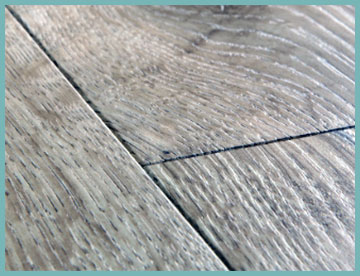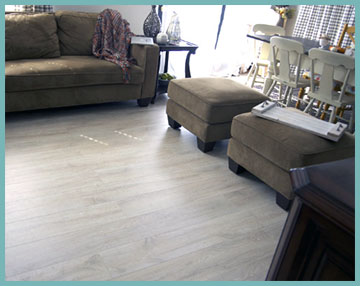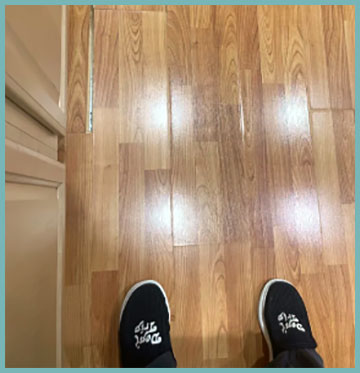When I decided to renovate my home, I wanted flooring that could handle my chaotic household—two kids, a dog, and my clumsy coffee spills—while still looking like it belonged in a design magazine. Quick-Step laminate flooring caught my eye with its promise of durability, style, and easy installation.
After living with it for over a year, I can confidently say it’s a game-changer for anyone seeking a balance of beauty and practicality. You should absolutely consider Quick-Step for your next flooring project—it’s a reliable choice that delivers on its promises. Let’s walk through my journey and why I think it’s worth your investment.
My Experience With Quick-Step Laminate Flooring

Stepping into my home renovation, I was overwhelmed by the sheer number of flooring options.
Hardwood felt too pricey and high-maintenance, while vinyl didn’t quite match the aesthetic I craved.
Then I stumbled across Quick-Step laminate at a local home improvement store.
The display of their NatureTek Plus line, with its rich oak textures and warm tones, immediately drew me in.
It looked like real wood but promised the durability and affordability I needed. I chose the NatureTek Plus French Country Oak for my living room and kitchen, hoping it would withstand my family’s daily chaos.
Installation was my first pleasant surprise. I’m no DIY expert, but Quick-Step’s Uniclic system made it feel like I was snapping together a giant puzzle. The planks clicked into place with satisfying precision, and I didn’t need glue or fancy tools.
With help from my partner, we laid about 500 square feet over a weekend, saving a chunk of cash by skipping professional installers. The underlayment provided with the NatureTek Plus added a cushioned feel underfoot, which was a nice bonus for long days spent standing in the kitchen.
Living with Quick-Step has been mostly a joy. My kids have spilled juice, dropped toys, and even dragged furniture across it, yet the floor still looks nearly pristine. The HydroSeal coating on the NatureTek Plus truly lives up to its waterproof claims—I once left a puddle from a knocked-over water glass for a few hours, and after a quick wipe, there was no trace of damage.
The texture feels authentic, not like the plasticky laminates I’d seen in older homes. It’s also surprisingly quiet to walk on, thanks to the underlay, which cuts down on that hollow, clicky sound some laminates have.
That said, it’s not perfect. I noticed some repetition in the grain patterns if you stare closely, which slightly breaks the “real wood” illusion in larger rooms. Also, while it’s marketed as scratch-resistant, my dog’s enthusiastic clawing during playtime has left a few faint marks.
Cleaning is straightforward, but the grooves can trap dust, requiring a bit of elbow grease for a deep clean. Overall, my experience has been overwhelmingly positive, and Quick-Step has transformed my space into something both functional and beautiful. It’s been a year, and I’m still thrilled with my choice.
Read More: My Thoughts On Lux Flooring
Pros Of Quick-Step Laminate Flooring
Quick-Step brings a lot to the table, and after using it daily, I’ve pinpointed what makes it stand out. Here’s why I think it’s a fantastic option for most homes:
- Stunning aesthetics: The realistic wood textures, especially in the NatureTek and Impressive lines, mimic hardwood so well that guests often assume it’s the real deal. From light maple to deep chestnut, the color options fit everything from cozy cottages to modern lofts.
- Impressive durability: The Scratch Guard technology and AC4 rating mean it handles heavy foot traffic, kids, and pets like a champ. My floor has endured countless spills and roughhousing with minimal wear.
- Waterproof options: The NatureTek Plus and Impressive Ultra lines come with HydroSeal, making them ideal for kitchens and bathrooms. I’ve tested this with accidental spills, and the floor stays unwarped and unstained.
- Easy installation: The Uniclic system is a DIYer’s dream. I laid my floor without prior experience, and the click-lock mechanism ensured tight, gap-free seams.
- Eco-friendly credentials: Quick-Step’s FloorScore certification and low-VOC emissions gave me peace of mind, knowing my family wasn’t breathing in harmful chemicals.
- Long warranties: Lifetime residential warranties for wear and fading, plus a WetProtect guarantee for water damage, show Quick-Step’s confidence in their product. It’s reassuring to know my floor is covered for decades.
- Affordable luxury: Priced between $2 and $4 per square foot, it’s a budget-friendly alternative to hardwood that doesn’t skimp on style or quality.
These strengths make Quick-Step a versatile choice, whether you’re updating a single room or an entire house. It’s hard to beat the combination of beauty, resilience, and ease for the price.
Cons Of Quick-Step Laminate Flooring

No product is flawless, and Quick-Step has its quirks.
While I love my floors, there are a few drawbacks you should know about before committing:
- Pattern repetition: In larger spaces, you might notice the wood grain patterns repeat, slightly undermining the natural look. It’s not a dealbreaker, but it bugged me when I first noticed it.
- Not dent-proof: Despite the Scratch Guard, heavy furniture or sharp objects can leave marks. A chair I slid without felt pads left a faint dent, which was frustrating.
- Groove cleaning challenges: The textured surface traps dust in grooves, requiring more than a quick sweep for a thorough clean. I’ve had to scrub by hand a few times to keep it spotless.
- Limited color variety in some lines: The Studio collection, while affordable, has fewer color options, which might limit your design choices if you’re on a tight budget.
- Noise in some settings: Without proper underlay, it can sound hollow or clicky, especially on concrete subfloors. My underlay helped, but I’ve heard complaints from others.
- Not fully waterproof: While NatureTek Plus is water-resistant, prolonged exposure to standing water can still cause issues. I learned to mop up spills quickly to avoid risks.
- Installation precision required: The Uniclic system is easy, but uneven subfloors or sloppy cuts can lead to gaps or loose planks. I had to redo a section because of my own rookie mistake.
These cons haven’t soured my love for Quick-Step, but they’re worth considering to ensure it fits your lifestyle and expectations.
Maintenance Tips For Quick-Step Laminate Flooring

Keeping your Quick-Step floors looking pristine is easier than you might think, but it does require some care.
Here’s how I’ve kept mine in top shape:
- Sweep or vacuum regularly: Dust and dirt can settle into the grooves, so I sweep daily with a soft-bristle broom or use a vacuum without a beater bar to avoid scratches.
- Use a damp mop sparingly: Quick-Step’s cleaning kit with a microfiber mop works wonders. I damp-mop every couple of weeks with their laminate-friendly cleaner, ensuring no excess water lingers.
- Wipe spills immediately: The HydroSeal is great, but I’ve learned to clean up spills right away to prevent any chance of water seeping into seams.
- Avoid harsh chemicals: I stick to Quick-Step’s recommended cleaners or mild detergents. Once, I tried a generic cleaner, and it left a streaky residue that took extra effort to remove.
- Use felt pads on furniture: To prevent dents, I’ve added felt pads to chair and table legs. It’s a small step that makes a big difference when moving furniture.
- Dry-mop for quick touch-ups: A dry microfiber mop is my go-to for quick dust removal between deep cleans. It’s fast and keeps the floor looking fresh.
- Avoid steam cleaners: Steam can damage the laminate’s core, so I steer clear. A damp cloth with a bit of elbow grease handles tough spots just fine.
These habits have kept my floors looking as good as the day they were installed. With a little routine care, your Quick-Step laminate will stay beautiful for years.
Comparison With Other Brands
Choosing laminate flooring means navigating a crowded market, and Quick-Step isn’t the only player. I’ve compared it to other top brands to help you decide if it’s the right fit.
Pergo
Pergo, another Mohawk brand, is often pitted against Quick-Step. Its Outlast Plus line is known for affordability, ranging from $1.50 to $3 per square foot, slightly cheaper than Quick-Step’s $2 to $4 range. Pergo’s SpillProtect technology offers decent water resistance, but I found Quick-Step’s HydroSeal more reliable for kitchens, as it handled my spills without a hitch.
Pergo’s designs are varied, but Quick-Step’s textures feel more authentic, especially in the Impressive line. Installation is similar with Pergo’s click-lock system, but some users report less precise joints compared to Quick-Step’s Uniclic. Pergo’s warranties are solid, with a 10-year limited residential guarantee, but Quick-Step’s lifetime warranties give it an edge for long-term confidence.

Mohawk
Mohawk, Quick-Step’s parent company, offers a broad range of laminates, including budget-friendly options around $2 per square foot and premium lines up to $10.
Mohawk’s RevWood Plus is a strong competitor with excellent waterproofing, rivaling Quick-Step’s NatureTek Plus.
However, Mohawk’s product lines can be confusing, with overlapping names that make shopping trickier than Quick-Step’s clear categories.
I appreciated Quick-Step’s focus on eco-friendly certifications like FloorScore, which Mohawk also offers but doesn’t emphasize as much.
Mohawk’s designs are stylish, but Quick-Step’s Uniclic system felt more intuitive during my DIY install.
Shaw
Shaw excels in durability, with laminates priced between $2 and $7 per square foot. Its Repel technology offers water resistance comparable to Quick-Step’s, but Shaw’s thicker boards (up to 12mm) feel sturdier underfoot than Quick-Step’s 8-10mm options. Shaw’s designs lean toward modern aesthetics, which might not suit traditional homes as well as Quick-Step’s versatile oak and hickory looks. Installation is DIY-friendly with Shaw’s click-lock system, but I found Quick-Step’s Uniclic slightly easier to handle. Shaw’s warranties are competitive, often matching Quick-Step’s lifetime residential coverage, but its higher price point makes Quick-Step a better value for budget-conscious buyers like me.
Armstrong
Armstrong focuses on timeless designs, with laminates priced from $2 to $5 per square foot. Its visuals are less varied than Quick-Step’s, leaning heavily on classic wood tones. Armstrong’s HydraCore technology offers water resistance, but it’s not as robust as Quick-Step’s HydroSeal for wet areas. Installation is straightforward, but Armstrong’s click-lock system isn’t as refined as Quick-Step’s Uniclic, which I found more forgiving for DIY errors. Armstrong’s warranties are decent, typically 20-30 years, but Quick-Step’s lifetime guarantees are more reassuring. For eco-conscious shoppers, Armstrong’s sustainability credentials are strong, but Quick-Step’s low-VOC certification feels more transparent.
Quick-Step holds its own against these brands, balancing style, durability, and ease of use at a reasonable price. Your choice depends on whether you prioritize cost, design variety, or specific features like waterproofing.
Read More: My Thoughts On Gemcore Flooring
Frequently Asked Questions (FAQ)
Quick-Step is a high-quality laminate flooring brand, and I can vouch for its performance in my home. Its AC4 rating ensures durability for residential and light commercial use, while features like Scratch Guard and HydroSeal make it resistant to scratches, stains, and water. The high-density fiberboard core and Uniclic system provide stability and ease of installation. With lifetime warranties and eco-friendly certifications like FloorScore, Quick-Step delivers reliable quality that’s stood up to my family’s daily wear and tear.
Choosing the “best” laminate brand depends on your needs, but Quick-Step is a top contender in my book. Its blend of realistic designs, durability, and DIY-friendly installation makes it versatile. Pergo offers great affordability, Shaw excels in sturdiness, and Mohawk has eco-friendly options, but Quick-Step’s balance of style, waterproofing, and long warranties gives it an edge for most homes. I’d recommend sampling a few brands to match your aesthetic and budget, but Quick-Step’s consistency is hard to beat.
Pergo and Quick-Step are both strong, but it’s a close call. Pergo’s lower price point ($1.50-$3 per square foot) makes it attractive for budget shoppers, and its SpillProtect technology handles light spills well. However, Quick-Step’s HydroSeal and Uniclic system felt more robust and user-friendly during my install. Quick-Step’s lifetime warranties outshine Pergo’s 10-year guarantees, and its textures look more authentic to me. If waterproofing and ease of installation are priorities, I’d lean toward Quick-Step, but Pergo’s a solid choice for cost-conscious buyers.
Quick-Step is manufactured by Unilin, a Belgian company under Mohawk Industries, a U.S.-based flooring giant. Unilin’s expertise in laminate and engineered wood shines through in Quick-Step’s innovative features like Uniclic and HydroSeal. Since starting in 1990, Quick-Step has built a reputation for quality, and being part of Mohawk ensures access to advanced manufacturing and distribution. This backing gives me confidence in the brand’s reliability and consistency.
Conclusion: For Quick-Step Laminate Flooring
After a year with Quick-Step laminate, I’m convinced it’s a stellar choice for anyone wanting durable, stylish flooring without breaking the bank. It’s transformed my home into a space that’s both practical for my busy family and elegant enough to impress guests. From easy installation to minimal maintenance, Quick-Step delivers on its promises. You should seriously consider it for your next project—it’s a decision I haven’t regretted, and I bet you won’t either.
